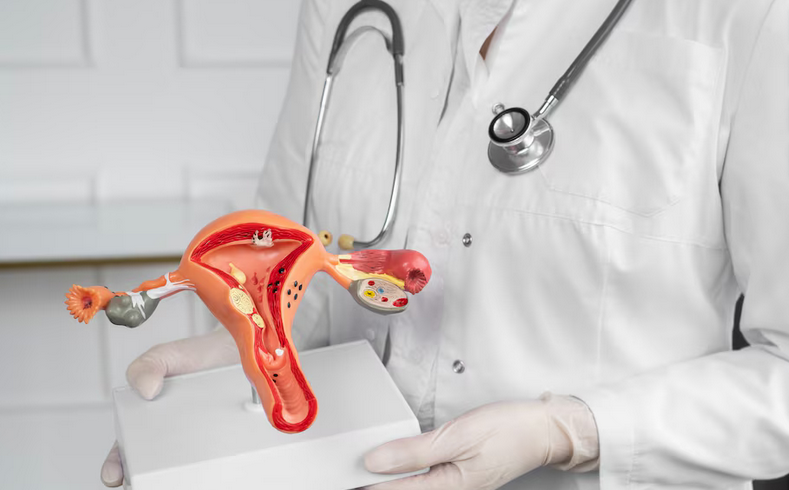
An ovarian cyst is a fluid-filled sac that develops on an ovary and can be painless and symptomless.
Ovarian cysts are common. They are usually just a sign of ovulation, occur naturally and go away in a few months without needing any treatment.
In some cases, however, they can point to an underlying condition and may need to be removed.
According to Medical News Today, the size of ovarian cysts can vary, and cysts smaller than 10 centimetres across often do not require treatment.
The publication states that a simple cyst contains fluid, while a complex cyst contains blood or a hard substance.
Types of ovarian cysts
Most ovarian cysts are functional cysts, which form in response to your body’s changes during your menstrual cycle. Less commonly, ovarian cysts form for reasons unrelated to your period.
Pathological ovarian cysts form as a result of abnormal cell growth. They are, however, much less common
Medical News Today lists seven types of ovarian cysts.
These include:
Follicle cysts: These develop when a follicle does not open to release an egg during menstruation.
They are the most common type of cyst, often produce no symptoms, and usually disappear in one to three months.
Corpus Luteum cysts: These form if the sac that released the egg does not shrink in the usual way but fills with fluid.
They usually disappear within weeks but can grow to almost four inches across.
They can also twist the ovary, causing pain and bleeding.
Endometriomas: This results from endometriosis, when endometrial-like tissue develops outside the womb.
It can cause pain during menstruation and sex.
Dermoid cysts: They develop from cells that are present from birth.
They can occur anywhere, including the ovaries.
Cystadenomas: These are cysts that fill with a watery fluid.
Polycystic ovary syndrome: This involves the development of many small cells.
It can result in pain and fertility problems and has links with other health conditions.
Ovarian cancer cyst: This involves cancerous cysts. These cysts are rare, but a doctor will usually follow up any type of cyst in case it is cancerous.
Symptoms of ovarian cysts
When one has ovarian cysts, they experience changes in menstruation, painful sexual intercourse, unusual vaginal bleeding, breast tenderness, lower back pain, and, nausea and vomiting.
Other symptoms include pressure on the bowels, frequent urination, problems when urinating, unexpected weight gain, bloating and swollen tummy, pelvic pain and feeling very full after only eating a little.
According to the National Health Service (NHS) of the UK, although ovarian cysts do not affect fertility, they can lead to difficulty getting pregnant.
Causes of ovarian cysts
The causes of ovarian cysts depend on the type.
According to Medical News Today, they include hormonal factors and drugs that help people ovulate and can lead to follicle and corpus luteum cysts, also known as functional cysts.
Further, having endometriosis increases the risk of developing endometriomas.
In pregnancy, the corpus luteum cyst releases progesterone to maintain the pregnancy. The placenta takes over this function and usually the corpus luteum cyst regresses. If it remains as it is or gets larger, a surgeon may need to remove it.
Additionally, another cause is infections that affect the ovaries and fallopian tubes can result in the formation of cysts.
Complications of ovarian cysts
Ovarian cysts often cause no problems. Sometimes they can, however, lead to complications.
Medical News Today says among the complications is torsion, which refers to the twisting of an organ or structure, which can cut off its blood supply.
In this case, an ovary can become twisted if a cyst is growing on it. It can block the blood supply to the cyst and cause severe pain in the lower abdomen. This is usually a medical emergency.
A ruptured ovarian cyst is a burst cyst. Symptoms include severe pain in the lower abdomen and possibly bleeding.
How to diagnose ovarian cysts
According to Healthline, an ovarian cyst can be detected during a routine pelvic exam. During the exam, a doctor may notice swelling on one of your ovaries and order an ultrasound to confirm the presence of a cyst.
Other methods of diagnosing ovarian cysts are CT scan and MRI.
Treatment of ovarian cysts
Healthline states that for benign ovarian cysts which develop symptoms, home remedies like heat therapy can help ease them.
Depending on the type of cyst, surgery may be needed.
Options for surgery include:
Laparoscopy: A doctor performs this surgery by making several tiny incisions near your navel and inserting a small instrument into your abdomen to remove the cyst.
Laparotomy: In this procedure, a doctor can surgically remove the cyst through a large incision in your abdomen. This is known as laparotomy. They can then do a biopsy if they are concerned about cancer.

















